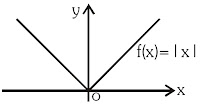DIFFERENTIABILITY
1. INTRODUCTION:
The derivative of a function 'f' is function ; this function is denoted by symbols such as
\(\mathrm{f}^{\prime}(\mathrm{x}), \dfrac{\mathrm{df}}{\mathrm{dx}}, \dfrac{\mathrm{d}}{\mathrm{dx}} \mathrm{f}(\mathrm{x})\) or \(\dfrac{\mathrm{df}(\mathrm{x})}{\mathrm{dx}}\)
The derivative evaluated at a point a, can be written as:
\(\mathrm{f}^{\prime}(\mathrm{a}),\left[\dfrac{\mathrm{df}(\mathrm{x})}{\mathrm{dx}}\right]_{\mathrm{x}=\mathrm{a}}, \mathrm{f}^{\prime}(\mathrm{x})_{\mathrm{x}=\mathrm{a}}\), etc.
2. RIGHT HAND & LEFT HAND DERIVATIVES:
(a) Right hand derivative :
The right hand derivative of \(\mathrm{f}(\mathrm{x})\) at \(\mathrm{x}=\) a denoted by \(\mathrm{f}_{+}^{\prime}(\mathrm{a})\) is defined as :
\(\mathrm{f}_{+}^{\prime}(\mathrm{a})=\displaystyle \lim_{\mathrm{h} \rightarrow 0^{+}} \dfrac{\mathrm{f}(\mathrm{a}+\mathrm{h})-\mathrm{f}(\mathrm{a})}{\mathrm{h}}\), provided the limit exists & is finite.
(b) Left hand derivative :
The left hand derivative of \(f(x)\) at \(x=\) a denoted by \(f^{\prime}(a)\) is defined as \(: f_{-}^{\prime}(a)=\displaystyle \lim_{h \rightarrow 0^{+}} \dfrac{f(a-h)-f(a)}{-h}\), provided the limit exists & is finite.
(c) Derivability of function at a point :
If \(f_{+}^{\prime}(a)=f^{\prime}(a)=\) finite quantity, then \(f(x)\) is said to be derivable or differentiable at \(\mathbf{x}=\mathbf{a}\). In such case \(\mathrm{f}_{+}^{\prime}(\mathrm{a})=\mathrm{f}_{-}^{\prime}(\mathrm{a})=\mathrm{f}^{\prime}(\mathrm{a}) \) & it is called derivative or differential coefficient of \(\mathrm{f}(\mathrm{x})\) at \(\mathrm{x}=\mathrm{a}\).
Note:
(i) All polynomial, trigonometric, inverse trigonometric, logarithmic and exponential function are continuous and differentiable in their domains, except at end points.
(ii) If \(f(x) \) & \(g(x)\) are derivable at \(x=\) a then the functions \(\mathrm{f}(\mathrm{x})+\mathrm{g}(\mathrm{x}), \mathrm{f}(\mathrm{x})-\mathrm{g}(\mathrm{x}), \mathrm{f}(\mathrm{x}) \cdot \mathrm{g}(\mathrm{x})\) will also be derivable at \(\mathrm{x}=\mathrm{a}\) & if \(g(a) \neq 0\) then the function \(f(x) / g(x)\) will also be derivable at \(x=a\).
3. IMPORTANT NOTE :
(a) Let \(\mathrm{f}_{+}^{\prime}(\mathrm{a})=\mathrm{p} \) & \( \mathrm{f}^{\prime}(\mathrm{a})=\mathrm{q}\)
When p & q are finite:
If \(\mathrm{p}\) and \(\mathrm{q}\) are finite (whether equal or not), then \(f\) is continuous at \(\mathrm{x}=\mathrm{a}\) but converse is NOT necessarily true.
(i) \( \mathrm{p}=\mathrm{q} \Rightarrow \mathrm{f}\) is differentiable at \(\mathrm{x}=\mathrm{a} \Rightarrow \mathrm{f}\) is continuous at \(\mathrm{x}=\mathrm{a}\) \(f^{\prime}(0)=0\) and \(f_{+}^{\prime}(0)=0 \Rightarrow \quad f^{\prime}(0)=0\), here \(\mathrm{x}\) axis is tangent to the curve at \(\mathrm{x}=0\).
(ii) \(\mathrm{p} \neq \mathrm{q} \Rightarrow \mathrm{f}\) is not differentiable at \(\mathrm{x}=\mathrm{a}\), but \(\mathrm{f}\) is still continuous at \(\mathrm{x}=\mathrm{a}\). In this case we have a sudden change in the direction of the graph of the function at \(\mathrm{x}=\mathrm{a}\). This point is called a corner point of the function. At this point there is no tangent to the curve.
When p or q may not be finite :
In this case \(\mathrm{f}\) is not differentiable at \(\mathrm{x}=\mathrm{a}\) and nothing can be concluded about continuity of the function at \(\mathrm{x}=\mathrm{a}\).
Note:
\(\circ\) Corner : If \(\mathrm{f}\) is continuous at \(\mathrm{x}=\) a with \(\mathrm{RHD}\) and \(\mathrm{LHD}\) at \(\mathrm{x}=\mathrm{a}\) both are finite but not equal or exactly one of them is infinite, then the point \(\mathrm{x}=\mathrm{a}\) is called a corner point and at this point function is not differentiable but continuous.
\(\circ\) Cusp : If \(\mathrm{f}\) is continuous at \(\mathrm{x}=\mathrm{a}\) and one of \(\mathrm{RHD}, \mathrm{LHD}\) at \(x=a\), approaches to \(\infty\) and other one approaches to \(-\infty\), then the point \(\mathrm{x}=\mathrm{a}\) is called a cusp point. At cusp point we have a vertical tangent and at this point function is not differentiable but continuous. We can observe that cusp is sharper than corner point.
(b) Geometrical interpretation of differentiability:
(i) If the function \(y=f(x)\) is differentiable at \(x=a\), then a unique tangent can be drawn to the curve \(y=f(x)\) at \(P(a,\), \(\mathrm{f}(\mathrm{a})) \) & \( \mathrm{f}^{\prime}(\mathrm{a})\) represent the slope of the tangent at point \(\mathrm{P}\).
(ii) If LHD and RHD are finite but unequal then it geometrically implies a sharp corner at \(\mathrm{x}=\mathrm{a}\). e.g. \(f(x)=|x|\) is continuous but not differentiable at \(\mathrm{x}=0\).
(c) Vertical tangent : If \(y=f(x)\) is continuous at \(x=\) a and \(\displaystyle \lim _{x \rightarrow a}\left|f^{\prime}(x)\right|\) approaches to \(\infty\), then \(y=f(x)\) has a vertical tangent at \(x=a\). If a function has vertical tangent at \(\mathrm{x}=\mathrm{a}\) then it is non differentiable at \(x=a\).
4. DERIVABILITY OVER AN INTERVAL :
(a) \(\mathrm{f}(\mathrm{x})\) is said to be derivable over an open interval \((\mathrm{a}, \mathrm{b})\) if it is derivable at each & every point of the open interval \((\mathrm{a}, \mathrm{b})\)
(b) \(\mathrm{f}(\mathrm{x})\) is said to be derivable over the closed interval \([\mathrm{a}, \mathrm{b}]\) if :
(ii) for the points a and \(b, f^{\prime}\) \(\left(\right.\) a) & \( \mathrm{f}^{\prime}\) (b) exist.
Note:
(i) If \(\mathrm{f}(\mathrm{x})\) is differentiable at \(\mathrm{x}=\mathrm{a} \) & \(\mathrm{~g}(\mathrm{x})\) is not differentiable \(\mathrm{at}\) \(x=a\), then the product function \(F(x)=f(x) \cdot g(x)\) can still be differentiable at \(\mathrm{x}=\mathrm{a}\).
(ii) If \(f(x) \) & \(g(x)\) both are not differentiable at \(x=a\) then the product function; \(\mathrm{F}(\mathrm{x})=\mathrm{f}(\mathrm{x}) \cdot \mathrm{g}(\mathrm{x})\) can still be differentiable at \(\mathrm{x}=\mathrm{a}\).
(iii) If \(f(x) \) & \(g(x)\) both are non-derivable at \(x=a\) then the sum function \(\mathrm{F}(\mathrm{x})=\mathrm{f}(\mathrm{x})+\mathrm{g}(\mathrm{x})\) may be a differentiable function.
(iv) If \(\mathrm{f}(\mathrm{x})\) is derivable at \(\mathrm{x}=\mathrm{a} \Rightarrow \mathrm{f}^{\prime}(\mathrm{x})\) is continuous at \(\mathrm{x}=\mathrm{a}\).
(v) Sum or difference of a differentiable and a non-differentiable function is always is non-differentiable.


Comments
Post a Comment